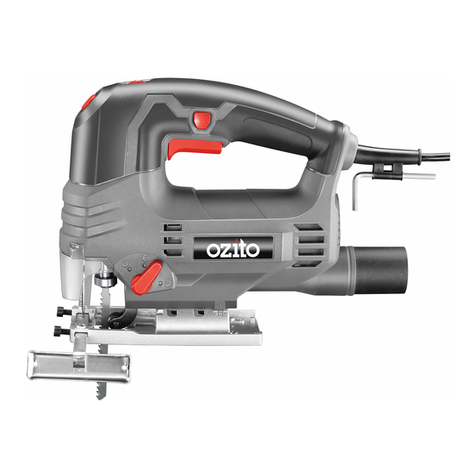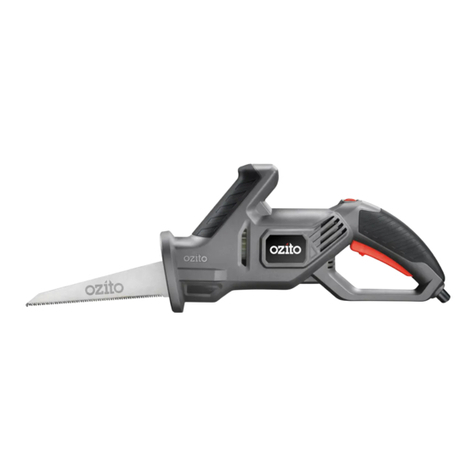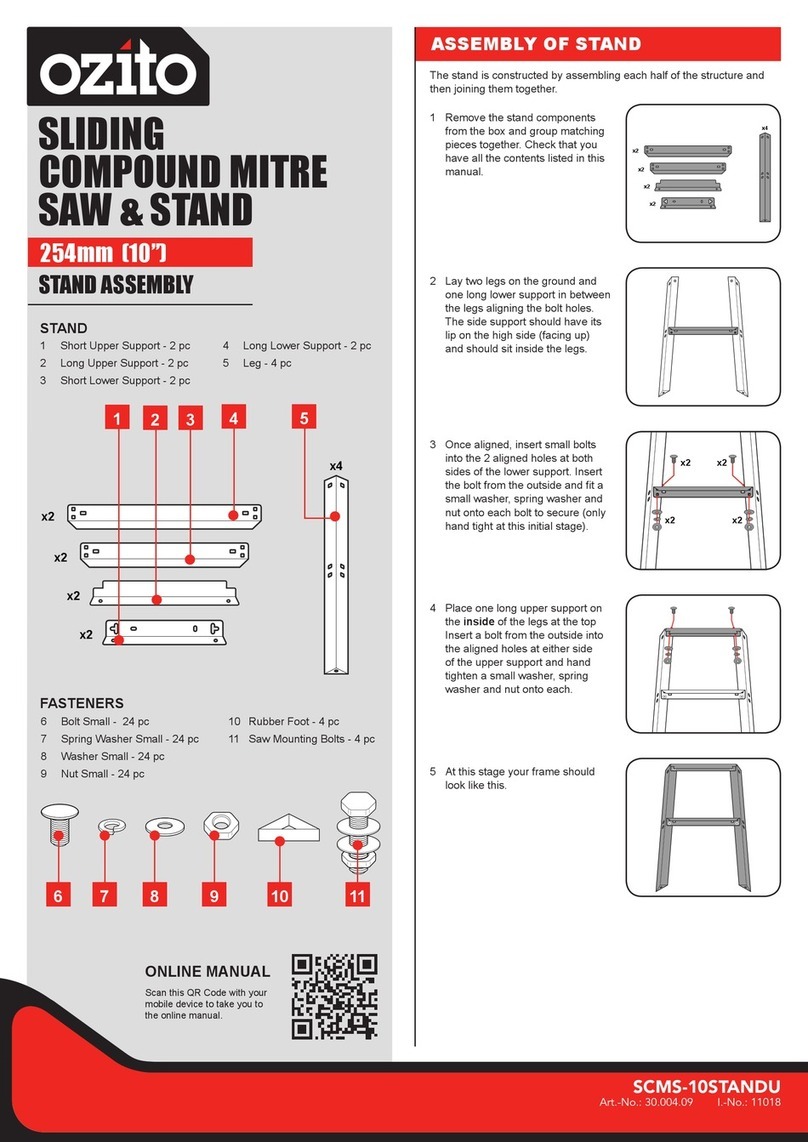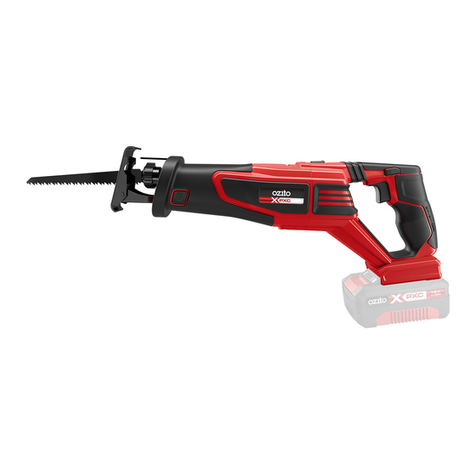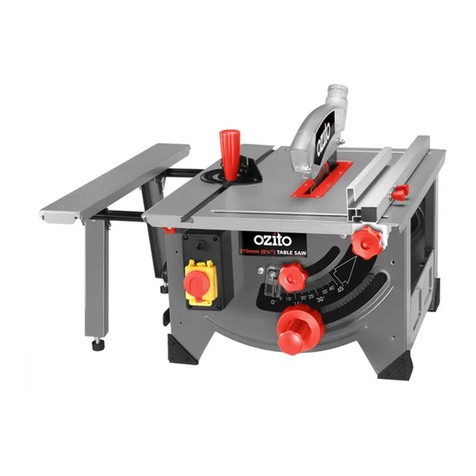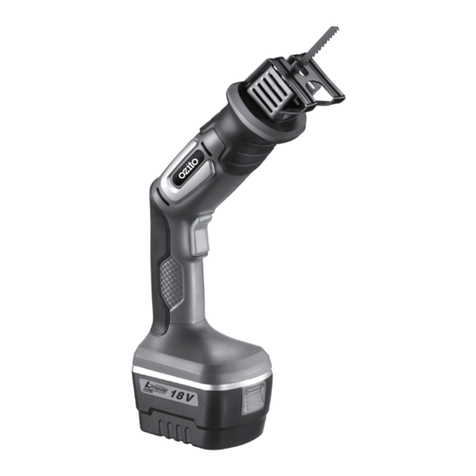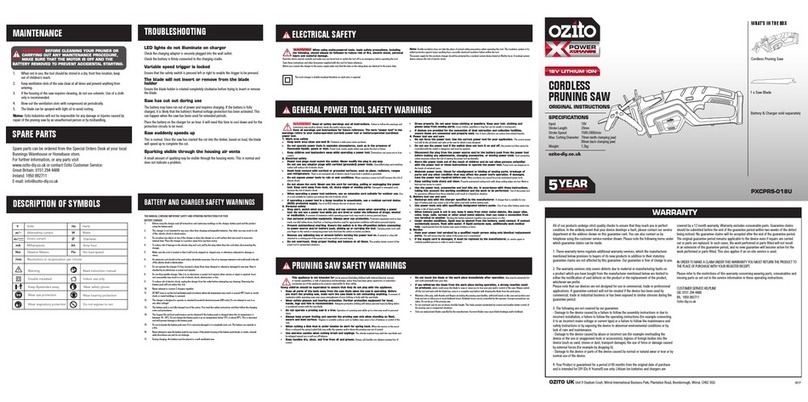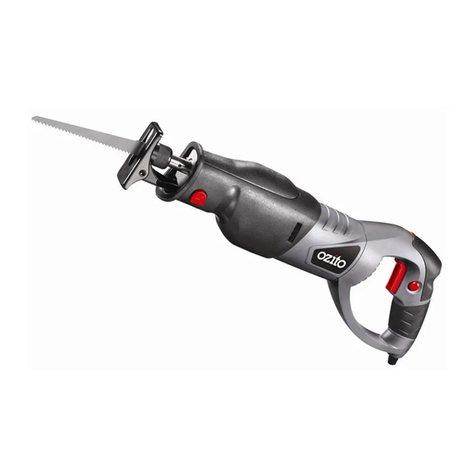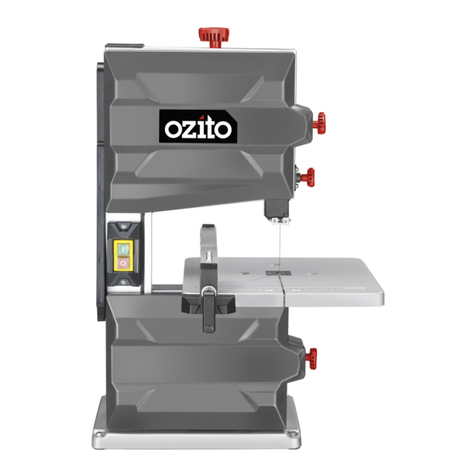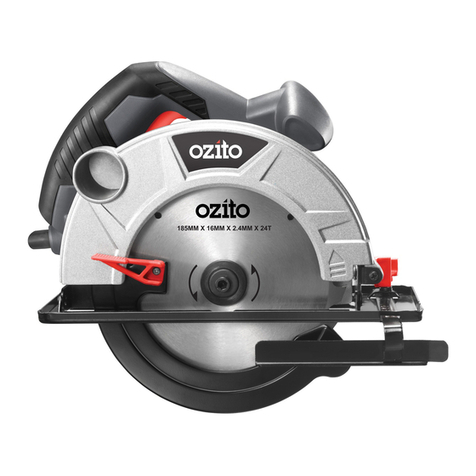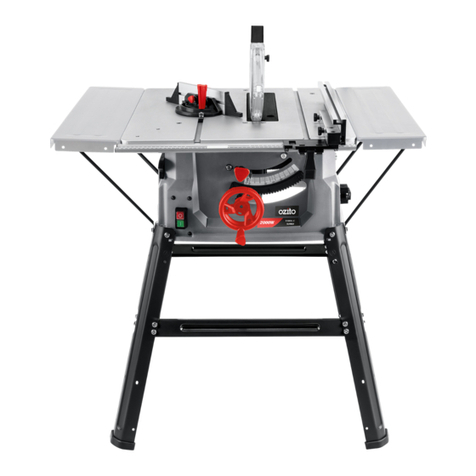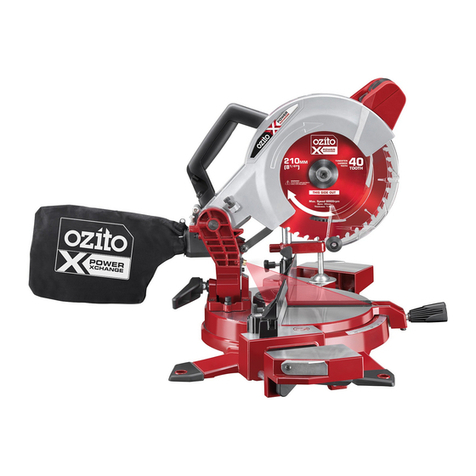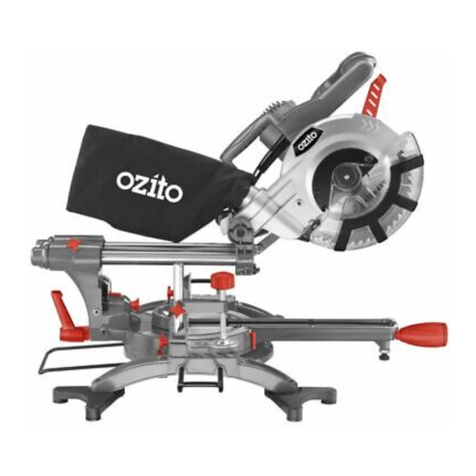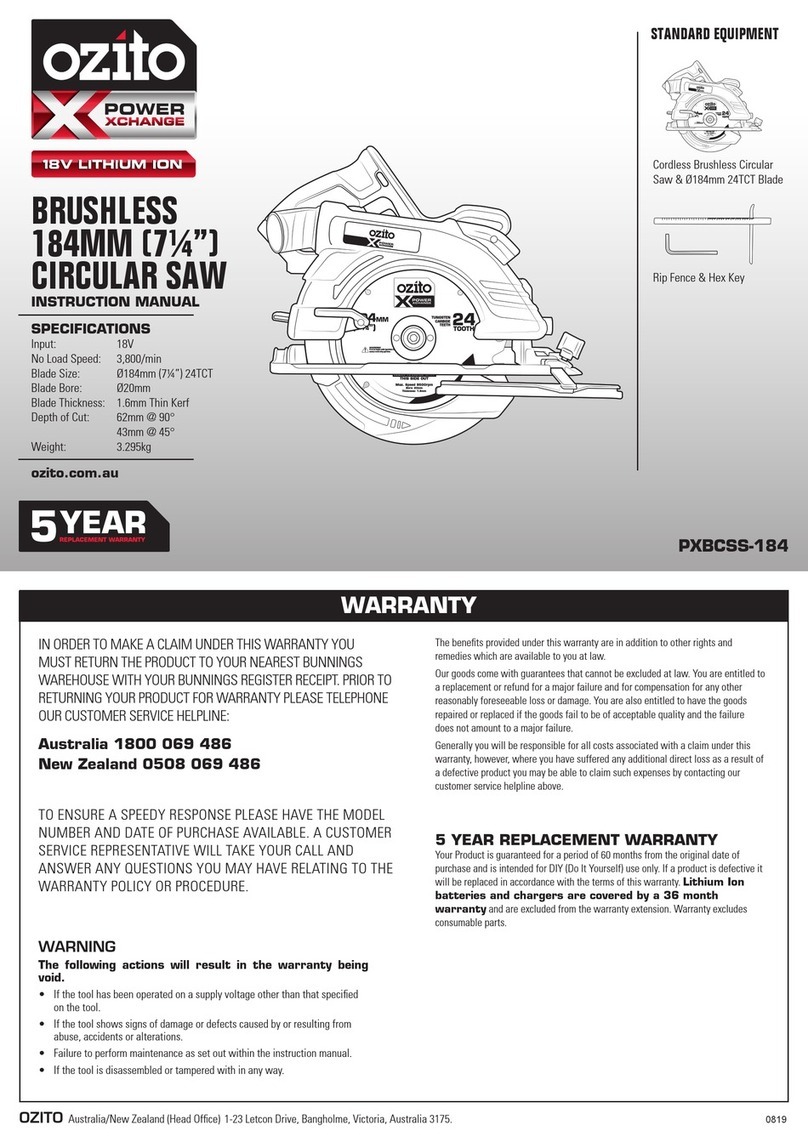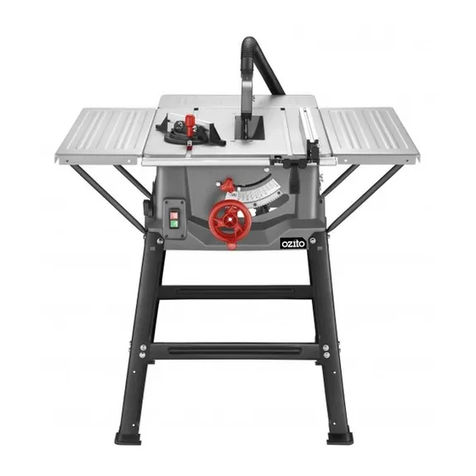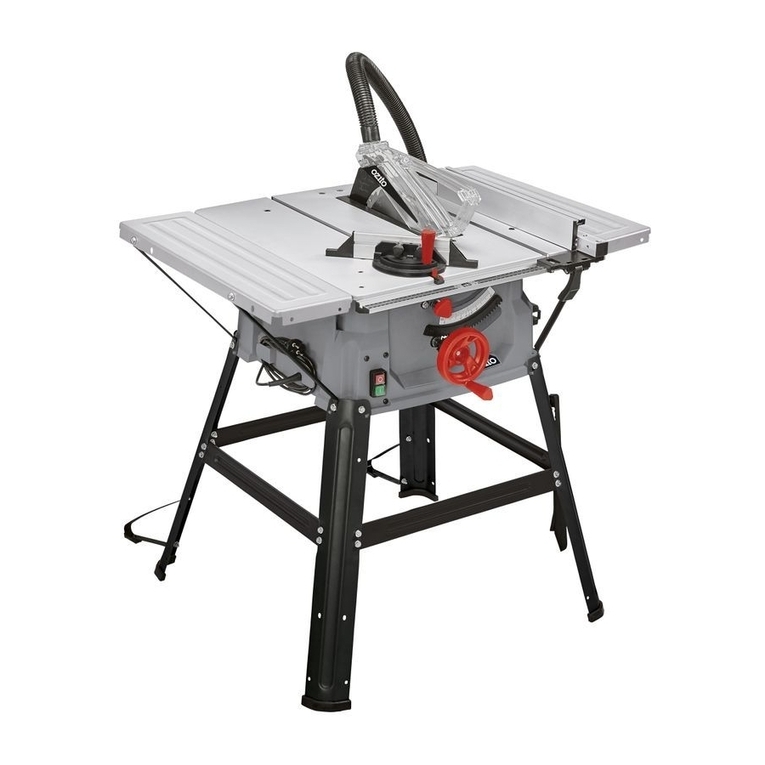
GENERAL POWER TOOL SAFETY WARNINGS - PERSONAL SAFETY
RECIPROCATING SAW SAFETY WARNINGS
WARNING!
• Hold power tool by insulated gripping surfaces, when performing an
operation where the cutting accessory may contact hidden wiring or its
own cord. Cutting accessory contacting a “live” wire may make exposed metal
parts of the power tool “live” and could give the operator an electric shock.
• This appliance is not intended for use by persons (including children) with
reduced physical, sensory or mental capabilities, or lack of experience and
knowledge, unless they have been given supervision or instruction concerning
use of the appliance by a person responsible for their safety.
• Recommendations for the use of a residual current device with a rated
residual current of 30mA or less.
• Wear a safety helmet, safety glasses and/or face shield. It is also highly
recommended that you wear a dust mask, ear protection and padded gloves.
• Check the blade carefully for cracks or damage prior to operation.
Replace cracked or damaged blades immediately.
• Hold the tool rmly during operation. Always hold the adjustable pivoting
shoe rmly against the work piece.
• Ensure no one is below you when using the tool in elevated conditions.
• Do not point the tool at anyone in the immediate vicinity.
WARNING! When making a “blind” cut (you can’t see behind what is being
cut), be sure that hidden electrical wiring or water pipes are not in the path of
the cut. If wires are present, they must be disconnected at their power source by a
qualied person or avoided to prevent the possibility of lethal shock or re.
• Water pipes in “blind” areas must be drained and capped before cutting.
• If the blade hits against objects during operation, damage to the tool or
dangerous blade breakage may occur.
• Watch out for cut-off portions of the work piece being cut. They may fall and
cause injury to you or someone near you.
• When cutting metals, be cautious of hot ying debris.
• Do not touch the blade or the work piece immediately after operation;
they may be extremely hot and could potentially burn your skin.
• If you withdraw the blade from the work piece during operation, a strong
reaction could be produced, which could cause the blade to snap or cause
you to lose your grip and/or control of the saw. Always switch off the tool and
wiat until the blade has come to a complete stop before with drawing the blade
from the work piece.
WARNING! Some dust created by power sanding, sawing, grinding, drilling and
other construction activities contain chemicals known to cause cancer, birth defects
or other reproductive harm.
Some examples of these chemicals are:
• Lead from lead-based paints;
• Crystalline silica from bricks, cement and other masonry products, and;
• Arsenic and chromium from chemically-treated timber.
The risk from such exposures vary depending on how often you do this type of work.
To reduce your exposure to these chemicals; work in a well ventilated area, and
work with approved safety equipment, such as those dust masks that are specically
designed to lter out microscopic particles.
Always wear eye protection and a dust mask for dusty applications and when drilling/
chiselling overhead. Sanding particles can be absorbed by your eyes and inhaled
easily and may cause health complications.
WARNING! Read all safety warnings and all instructions. Failure to follow the warnings and
instructions may result in electric shock, re and/or serious injury.
Save all warnings and instructions for future reference. The term “power tool” in the
warnings refers to your mains-operated (corded) power tool or battery-operated (cordless) power
tool.
1. Work area safety
a. Keep work area clean and well lit. Cluttered or dark areas invite accidents.
b. Do not operate power tools in explosive atmospheres, such as in the presence of ammable
liquids, gases or dust. Power tools create sparks which may ignite the dust or fumes.
c. Keep children and bystanders away while operating a power tool. Distractions can cause you to
lose control.
2. Electrical safety
a. Power tool plugs must match the outlet. Never modify the plug in any way. Do not use any
adapter plugs with earthed (grounded) power tools. Unmodied plugs and matching outlets will
reduce risk of electric shock.
b. Avoid body contact with earthed or grounded surfaces, such as pipes, radiators, ranges and
refrigerators. There is an increased risk of electric shock if your body is earthed or grounded.
c. Do not expose power tools to rain or wet conditions. Water entering a power tool will increase the
risk of electric shock.
d. Do not abuse the cord. Never use the cord for carrying, pulling or unplugging the power tool.
Keep cord away from heat, oil, sharp edges or moving parts. Damaged or entangled cords increase
the risk of electric shock.
e. When operating a power tool outdoors, use an extension cord suitable for outdoor use. Use of a
cord suitable for outdoor use reduces the risk of electric shock.
f. If operating a power tool in a damp location is unavoidable, use a residual current device (RCD)
protected supply. Use of an RCD reduces the risk of electric shock.
3. Personal safety
a. Stay alert, watch what you are doing and use common sense when operating a power tool. Do
not use a power tool while you are tired or under the inuence of drugs, alcohol or medication. A
moment of inattention while operating power tools may result in serious personal injury.
b. Use personal protective equipment. Always wear eye protection. Protective equipment such as dust
mask, non-skid safety shoes, hard hat, or hearing protection used for appropriate conditions will reduce
personal injuries.
c. Prevent unintentional starting. Ensure the switch is in the off-position before connecting to
power source and/or battery pack, picking up or carrying the tool. Carrying power tools with your
nger on the switch or energising power tools that have the switch on invites accidents.
d. Remove any adjusting key or wrench before turning the power tool on. A wrench or a key left
attached to a rotating part of the power tool may result in personal injury.
e. Do not overreach. Keep proper footing and balance at all times. This enables better control of the
power tool in unexpected situations.
f. Dress properly. Do not wear loose clothing or jewellery. Keep your hair, clothing and gloves away
from moving parts. Loose clothes, jewellery or long hair can be caught in moving parts.
g. If devices are provided for the connection of dust extraction and collection facilities, ensure
these are connected and properly used. Use of dust collection can reduce dust-related hazards.
h. Do not let familiarity gained from frequent use of tools allow you to become complacent and
ignore tool safety principles. A careless action can cause severe injury within a fraction of a second.
4. Power tool use and care
a. Do not force the power tool. Use the correct power tool for your application. The correct power tool
will do the job better and safer at the rate for which it was designed.
b. Do not use the power tool if the switch does not turn it on and off. Any power tool that cannot be
controlled with the switch is dangerous and must be repaired.
c. Disconnect the plug from the power source and/or the battery pack from the power tool before
making any adjustments, changing accessories, or storing power tools. Such preventive safety
measures reduce the risk of starting the power tool accidentally.
d. Store idle power tools out of the reach of children and do not allow persons unfamiliar with the
power tool or these instructions to operate the power tool. Power tools are dangerous in the hands
of untrained users.
e. Maintain power tools. Check for misalignment or binding of moving parts, breakage of parts and
any other condition that may affect the power tool’s operation. If damaged, have the power tool
repaired before use. Many accidents are caused by poorly maintained power tools.
f. Keep cutting tools sharp and clean. Properly maintained cutting tools with sharp cutting edges are
less likely to bind and are easier to control.
g. Use the power tool, accessories and tool bits etc. in accordance with these instructions, taking
into account the working conditions and the work to be performed. Use of the power tool for
operations different from those intended could result in a hazardous situation.
h. Keep handles and grasping surfaces dry, clean and free from oil and grease. Slippery handles and
grasping surfaces do not allow for safe handling and control of the tool in unexpected situations.
5. Service
a. Have your power tool serviced by a qualied repair person using only identical replacement
parts. This will ensure that the safety of the power tool is maintained.
